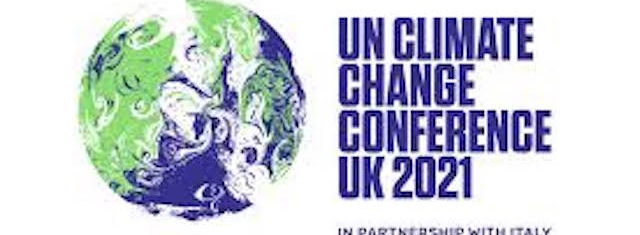News
RANA FROM REN 21 IS CONNECTING THE RIGHTS DOTS A WAY TO TACKLE CHALLENGES
IN DRIVING STRUCTURAL CHANGE

COP26 Logo (Source: COP26)
USPA NEWS -
« Mainstreaming efficiency and renewable energy is a transformational process that is not only technological (our preferred silver bullet), but also political, economic and societal. All of them. Political, economic and societal. Overwhelming, right? “¦especially when you know that the share of renewable energy in final energy consumption is roughly 11%. Incorporating all three is not especially within the comfort zone of a deeply technical (not technological) global community of renewable energy experts. And to add: we only have 10 years left (well, its the end of December 2020, so actually 9 years) to make the shift happen in time, knowing that the 5th anniversary of the Paris agreement has reminded us that we are very far from being on track“¦ Are you still breathing? » We are publishing the full text of Rana´s (Rana Adib´s lengthy statement, as they are suggesting some chalenges to be tackled over structural changes for the renewable energy and efficiency. Source : REN21
STRESS AND OUR AUTOMATIC RESPONSES-----------------------------------------------------------------------------------------
« In such moments of “˜stress´ part of our brain, the amygdala, triggers deeply anchored reflexes and we freeze, escape or attack. Personally, I observe that many of the players working on climate and development seem to attack and do even more of what they have already done ““ just think about the ever-increasing amount of communications, summits, alliances, analysis, meetings and webinars. However, we only have 24 hours in a day and the human body and soul have boundaries to respect. Many players wonder how and if this increased activity will contribute to accelerating the change required, especially in an economic crisis and a polarized political environment.-------------------------------------------------------------------------------
What also happens in such moments of “˜stress´: we are not in a space where we are able to step back or tap into our creativity ““ this is neurological, the brain waves are at the opposite spectrum. Our habits kick in, we go into our comfort zones“¦ and we do what we always do (admittedly, this is a bit simplified).
Often, especially as “technical“ experts, our natural stress reactions lead to us closing in on the issue, putting our focused attention on the problem to solve, and going deeper (of course this is to some extent also required - the devil is in the details). By doing so, however, we can ignore relevant problems and also powerful leverages and solutions outside of our field of vision. » Source REN21
CHOOSING DIVERSITY TO BROADEN THE FOCUS----------------------------------------------------------------------------------
« Consciously deciding to broaden our focus and expose ourselves to other, even opposite, perspectives as well as diverse disciplines, is a real leverage to drive and accelerate change. And this new focus brings a wide range of opportunities to position renewable energy in the broader political and socio-economic context that, personally, I find not only exciting and stimulating but certainly one of the main reasons why I am more hopeful today.
In fact, we have been able to hear such diverse perspectives at the REN21 Academy in November. We deliberately decided to bring topics like driving change and leadership, and voices from outside the renewable energy sector ““ including from oil & gas ““ to the REN21 community. (To inspire you, some of the videos from the event are on the REN21 Academy Knowledge Library on our website.) » Source REN21
HERE ARE ONLY SOME OF MY PERSONAL TAKE AWAYS-------------------------------------------------------------------------
“¢ Diversity is messy and complex, but diversity is strong. Choosing diversity, e.g. in interdisciplinary or multi-cultural teams, means developing a culture of listening, communicating and tolerance but also the readiness to confront yourself with other perspectives, norms and value systems (tough). Creating consultation processes and dialogues is not enough. We need to build spaces for real, deep exchange, “˜bonding´ and co-development.
“¢ Understanding change-dynamics to become strategic. Change does not happen in a linear way and, ultimately, it requires only a small number to reach the tipping point and make change happen. Three factors that power “social epidemics“ (Malcolm Gladwell´s wording for massive social changes): people, the infectious agent and the environment.[1] Being strategic therefore requires strengthening all ingredients (individual skills, messaging, an enabling environment) and creating concrete opportunities and spaces to bring them together.
“¢ Connecting the right dots. Connecting pioneers and early adopters within the renewable energy bubble with sustainable development and climate pioneers and early adopters outside this bubble, is a way to overcome ecosystem-inertia and create systemic pressure. Also, though many announcements are not backed by an implementation plan, some really encouraging announcements and actions exist in various sectors, from governments, finance and corporations, and can be connected together for incremental yet exponential change.
“¢ Be the solution for somebody´s problem. Renewables might be a solution to problems that other problem-solvers, in their own bubble, might not yet have identified.
“¢ Diversify the skill sets. Complementing our technical expertise with soft skills is a way to broaden our perspective and build leadership. It is however difficult to be good at everything so, again, connecting and collaborating is key.
To end with, I would sincerely like to thank all “˜voices´ that crossed my path and have inspired me personally and our work at REN21. Exhausted from this crazy year, but with hopeful perspectives, I wish you all a very good summer or winter break and look forward to connecting again in 2021.All the best, Rana, REN21 (Source REN21)
Ren21 Cop25 Cimate Change Rana Adib Renewable Energy Carbon Efficiency Jedi Foster Rahma Sophia Rachdi
Liability for this article lies with the author, who also holds the copyright. Editorial content from USPA may be quoted on other websites as long as the quote comprises no more than 5% of the entire text, is marked as such and the source is named (via hyperlink).







